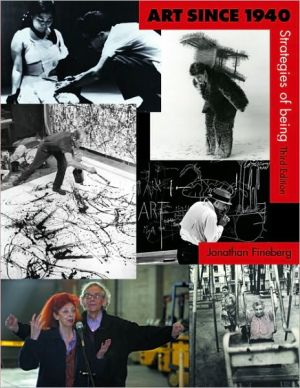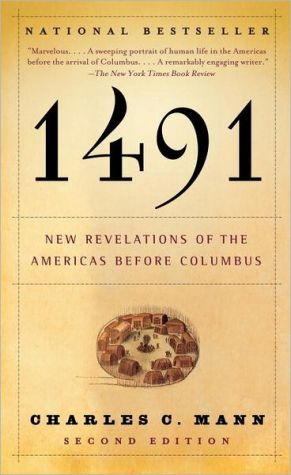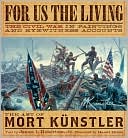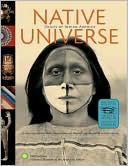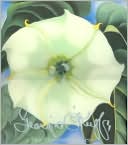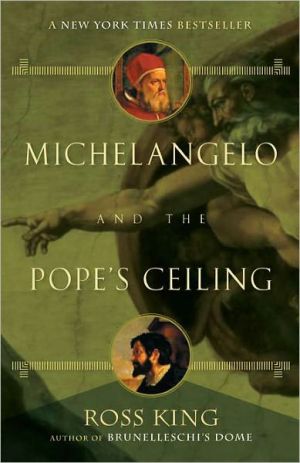Art Since 1940
The premise of this book is that artists use their art to think about their experience; it gives them a language in which to work out a way of existing in the world. So the front and back of the cover are illustrated with some of the great artists featured in the book doing their work.\ FRONT COVER:\ 1. Yoko Ono in the first performance of Cut Piece, Yamaichi Hall, Kyoto, 1964\ photo courtesy Lenono Photo Archive © Yoko Ono\ 2. Ann Hamilton wearing her 1984 # 13: Toothpick Suitchair\ photo...
Search in google:
This comprehensive and authoritative book illustrates art from the 1940's and stresses the individuality of the artists in relation to their political, social, and cultural contexts.The book focuses on the meaning of the major works and innovations. It features nearly 600 illustrations (approximately half in color) representing art since 1940, both in Europe and America. It explores the full range of periods, artists, and movements: New York in the Forties; Calder, Hofmann, Gorky, Motherwell, De Kooning; Existentialism (Pollock, Newman, Rothko, David Smith); The New European Masters of the Late Forties (Dubuffet, Giacometti, Bacon), plus so much more.For anyone interested in Postwar Art.
Foreword to the Third EditionAcknowledgmentsPreface1 IntroductionApproaching Art as a Mode of ThoughtModernismThe Concept of the Avant-GardeModernism’s Radical Individuality and Self-CritiquePostmodernismAn American Perspective/the Perspective of this Book2 New York in the Forties New York Becomes the CenterSurrealismWilfredo LamRoberto MattaJoseph CornellAmerican Pragmatism and Social RelevanceThe Depression and the Works Progress Administration (W.P.A.)The Availability of European ModernismThe Europeans in New YorkThe Sense of a New Movement in New YorkCommonalities and Differences Among the Artists of the New York SchoolAutomatism and Action in the Art of the New York SchoolAction and ExistentialismClyfford StillAdolph GottliebFranz KlineFriends in and around the New York SchoolAlternative Narratives of the FortiesJacob LawrenceHedda SterneLouise BourgeoisPhotography in the Era of the New York SchoolWeegee and Lisette ModelAaron Siskind and the Chicago School3 A Dialog with Europe Alexander CalderCalder's Early Life and ThemesCalder in ParisCosmic Imagery and the MobilesHans HofmannStylistic Lessons from EuropeHofmann's Art TheoryHofmann's PaintingArshile GorkyGorky's Life (Real and Imagined)The Development of Gorky's StyleGorky's Late WorksRobert MotherwellIntellectual Affinities with the European ModernsRecurring Themes in Motherwell's WorkTeaching, Writing, and Editing in Motherwell's Early CareerMotherwell's PaintingWillem de KooningDe Kooning's Training and Early CareerThe Dissolution of Anatomy into AbstractionThe Anatomical Forms Dissolve into BrushstrokesDe Kooning's Abstractions of the FiftiesThe "Women" of the Sixties and the Late Works4 Existentialism Comes to the Fore Jackson PollockPollock's Early Life and InfluencesPollock's Breakthrough of the Early FortiesPollock's Transition to a Pure Gestural StyleThe Dripped and Poured CanvasesPollock in the FiftiesBarnett NewmanThe Revelation of Newman's Onement I The Paintings of the Late FortiesVir Heroicus Sublimis and Other Works of the FiftiesThe "Stations of the Cross"Mark RothkoRothko's Formative YearsTurning to Classical MythSurrealism, Psychoanalysis, and "the Spirit of Myth""Heroifying" the IneffableThe Murals and Other Late WorkDavid Smith and the Sculpture of the New York SchoolSmith's Initiation into the Art WorldThe Aesthetic of Machines and the UnconsciousThe Pictograms and Hudson River Landscape An Existential Encounter with the Materials at HandCareer Success and Personal SacrificesThe Figural Presence and the Work of the Last Decade5 The New European Masters of the Late Forties Jean Dubuffet and Postwar ParisDubuffet's Painting of the FortiesDubuffet's Philosophical PremisesA Focus on Matter in the FiftiesA Grand Style of EntropyThe Existentialist Figuration of Alberto GiacomettiFrancis Bacon6 Some International Tendencies of the Fifties Purified Abstraction 1An Encounter with the Physicality of the Materials in EuropeA Material Reading of Action Painting in New YorkGreenberg's Definition of ModernismThe Greenberg SchoolFormalist Painting"New Images of Man" in Europe and AmericaThe CobraThe Figurative Revival of the FiftiesFigurative Painting in the Bay AreaChicago’s Existential Imagist7 The Beat Generation "A Coney Island of the Mind"John CageMerce CunninghamThe Cage "Event" of 1952Robert RauschenbergThe Self as a Mirror of LifeRauschenberg's Early CareerThe Combine PaintingsThe Drawings for Dante's Inferno The End of the CombinesThe Silkscreen PaintingsPerformance and the Prints of the Later SixtiesReal: Junk Assemblage and HappeningsUnderground FilmThe Genesis of the HappeningsThe Judson Dance TheaterWalk-in PaintingsClaes OldenburgThe "Cold Existentialism" of the "Ray Gun" and The Street The Store DaysSoft SculptureProposals for MonumentsRealizing Monuments and the Architectural ScaleJasper Johns"Nature" Is How We Describe ItPainting as a Discourse on LanguageAn Aesthetic of "Found" ExpressionEmotion and DistanceIncorporating Objects: What One Sees and What One KnowsThe Paintings of 1959The New Emotional Tone of the Early SixtiesExplorations of Linguistic PhilosophyDiver of 1962Periscope (Hart Crane) The Perceptual Complexity of LookingDropping the Reserve8 Asian and European Vanguards of the Later Fifties Nouveau RéalismeYves Klein's RomanticismLe Vide The "Living Brash"Seeking ImmaterialityKlein's DemiseThe Nouveaux Réalistes GutaiFluxusJoseph BeuysRevealing the Animism in NatureThe Artist as ShamanArt as the Creative Life of the MindNam June Paik’s Electronic “Nature”Yoko Ono9 The Landscape of Signs: American Pop Art The Electronic ConsciousnessA Turning Point in TheoryBritish Pop: From the Independent Group to David HockneyKey Figures of the Independent GroupThe ExhibitionsPaolozzi and Hamilton as ArtistsPopular Imagery into High ArtDavid HockneyCollaging Reality on Pop Art's Neutral Screen of ImagesAndy WarholWarhol's BackgroundSelecting NonselectivityEliminating the Artist's TouchA Terrifying EmptinessThe Factory SceneBusiness Art and the "Shadows" that Linger Behind ItRoy LichtensteinJames RosenquistChicago and Points WestH.C. WestermannPeter SaulThe Hairy WhoWest Coast PopFunk ArtPeter VoulkosThe Politicized Cultural Climate of the SixtiesWilliam WileyEd KienholzL.A. PopRobert ArnesonArneson's Break with Conventional CeramicsThe ToiletsA Technical BreakthroughObjects of the Mid-SixtiesThe Self-PortraitsDiscovering a Political VoiceIntrospection Via Pollock10 In the Nature of Materials: The Later Sixties Back to First Principles–Minimal ArtFrank StellaDonald JuddTony SmithCarl AndreDan FlavinRobert MorrisSol Le WittThe Los Angeles Light and Space MovementObject/Concept/Illusion in PaintingA Focus on Surface Handling in PaintingEva Hesse and Investigations of Materials and ProcessEva HesseThe Direct Sensuality of Fiberglass and LatexBruce Nauman and Richard SerraBruce NaumanRichard TuttleRichard SerraArtists Working in the LandscapeMichael HeizerWalter De MariaRobert SmithsAn Accidental RubricArte Povera, and a Persevering Rapport with Nature in Europe11 Politics and Postmodernism The Critical Atmosphere at the End of the SixtiesLanguage and MeasureRecasting PhotographyArt and NatureVito Acconci: Defining a Conceptual Oeuvre Body ArtAna MendietaLygia ClarkHélio OiticicaPerformance ArtPolitical CommentMarcel BroodthaersSituationismThe Potential for Broader Political ActionChristo and Jeanne-ClaudeArt in the Theater of Real EventsThe Shift to an Architectural ScaleThe Logistics of the ProjectsSurrounded Islands Christo and Jeanne-Claude in the Nineties and BeyondPostmodernismSigmar PolkeGerhard RichterJohn BaldessariTransition to the Seventies12 Corporate Culture and its Enemies A “New” PluralismRomare BeardenBearden's Collages of the SixtiesIdentity, Corporate Culture, and PluralismArt and FeminismA Dazzling PhotorealismEveryday PlacesAppropriated Sites: Charles SimondsGordon Matta-Clark's Site CritiquesAlice AycockAycock's Work of the EightiesCultural ComplexityMedia as a MediumAppropriationCindy Sherman13 Painting in the Seventies Philip Guston's Late StyleGuston's Early CareerGuston's Action Paintings of the FiftiesThe Re-emergence of the FigureNew Expressionist Painting in EuropeJörg Immendorff's Political Analysis of Painting in the SeventiesIdentity on the Plane of ImagesGeorg Baselitz and A.R. PenckAnselm KieferItalian Neo-ExpressionismFrancesco ClementeNew Image PaintingElizabeth MurrayThe Origins of Murray's StylePursuing the Logic of the Shaped CanvasThe Internationalization of Neo-ExpressionismAmerican Neo-expressionism14 The Eighties Complexity Settles InA Fresh Look at AbstractionAn Expressionism Beyond Medium: Jonathan BorofskyGraffiti ArtKeith HaringThe East Village Scene of the EightiesJean-Michel BasquiatDavid WojnarowiczEighties InstallationThe Peculiar Case of the RussiansIlya KabakovKabakov in the WestThe Aesthetic of ConsumerismPolitical Appropriation15 The Nineties Keeping it RealReturn to the BodyAnn HamiltonTransgressive Dislocations of the BodyMatthew BarneyFashionControversial MethodsPostmodern ConceptualismConstructing the Postmodern SelfLouise BourgeoisNew Uses of the CameraVideoSlippage: Fred TomaselliRoxy Paine’s TaxonomyCultural IdentityKerry James MarshallThe ComicsGlobal Culture and Local MeaningChina16 A New Century, A Changed World Violated BoundariesEconomies“©Murakami”: Branding the SelfConrad Bakker–Parsing the Fictions of Real EconomiesAndrea Fraser: Context and SelfDetached SubjectivityIdentity and Shopping: Sang-ah ChoiDissolution, Dislocation, Displacement of Boundaries–An Autopsy on IdentityAn Alternative History17 To Say the Things That Are One's Own BibliographyNotesIndex
\ From the PublisherFineberg's new edition is the book to learn modern art from--many times over. No other study is as truly comprehensive. Always sensitive to the political context of modern and contemporary art, Fineberg resists playing ideological favorites. Every artist, every medium, receives a sympathetic, informative view in accessible prose that never dodges the inherent complexities. Follow Fineberg as he moves from accounts of the careers of Willem de Kooning and Jackson Pollock to the fantasy world of Maya Deren's filmmaking, to Alfredo Jaar's manipulations of public information, to Kerry James Marshall's drawings of black superhero comics, to the cultural appropriations of Nikki S. Lee, and on and on. It's all there, and it's all succinctly, yet deeply, authoritatively, considered. --- Richard Shiff, The University of Texas at Austin\ The great value of Fineberg’s account of the art of the past seventy years is its attentiveness to what happens for artists in the course of their work, how the play of individual circumstances makes breakthrough moments possible, and how the life of art is always as well an experiential record of ways of living. ---Franklin "Buzz" Spector, Washington University in St. Louis\ \ \
